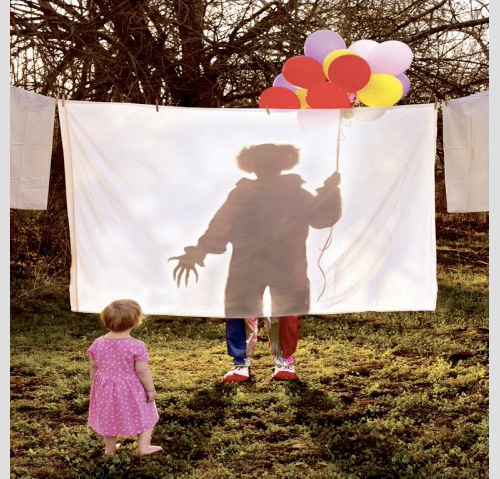
Image Credit: Joshua Hoffine
With Halloween on the horizon, I thought I'd take a break from the horror show of the campaign to consider some more visceral scares, and photographer Joshua Hoffine provides viscera aplenty in his works. The image above is one of Hoffine's tamer outings, though it is still disturbing. A small child stands outside before a clothes line hung with drying laundry. The sun shines behind a large white sheet, casting the shadow of a clown holding a bunch of balloons in one hand and displaying a set of menacing claws on the other. Hoffine uses children in many of his photos, contrasting the innocence and helplessness of childhood with the savage agency of monsters human and supernatural. Before we look at other photos, I suggest readers consider the images below the fold not safe for work or for those who prefer to avoid depictions of bodily violence and mutilation, death and decomposition, children in life threatening scenes, or children posed near their dead, violently murdered, parent's corpses.
Unlike many horror books and films where tension is built over time by hinting at or showing fleeting glimpses of the monster, the still photograph lacks a diachronic dimension. The image must choose one of three options: it can hint at some undepicted horror, depict some partial glimpse, or show it straight on. Hoffine's latest work, a dyptych of Jack The Ripper just before and after he kills and disembowels a woman, gestures toward a sense of elapsed time, but I don't find this work as affective as some of his other images. Readers can click through the links to see the pair, but I'm not including them here because I see such Ripper imagery as more exploitative than imaginative. I find the violence of the real world tragic and depressing and prefer the thrills and chills of zombies and ghouls. There is something about the bluntness of the evisceration that makes me read the image differently than other Hoffine works, akin to my distaste for the torture horror films of recent years contrasted with the still-horrific yet more pscyhologically-engaging-if-disturbing body horror in the style of Cronenberg, though this line of argument goes beyond the still images I want to consider in this post.
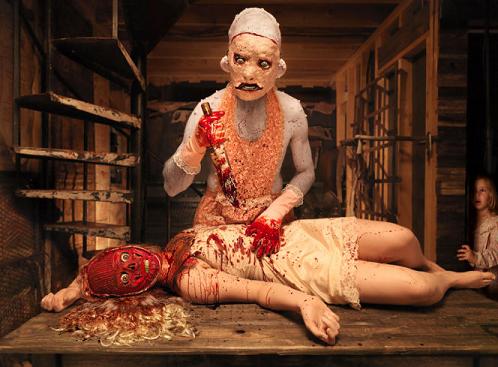
Image Credit: Joshua Hoffine
The first time you see Hoffine's more explicit images, the shock may be greater than his non-explicit works, but I find that they are not the works that stay most prominently in my memory. Sure, seeing a humanoid murderer wearing the stretched out skinned face of a mother, while her corpse lays on a table with her daughter coming around a corner in the background is shocking, but it lacks the anticipation offered in other works. And that anticipation, the waiting for the monster to act, helps embed the image in my mind, as if I'm continually expecting the action to complete itself, such as with the clown monster or the basement monster photo below.
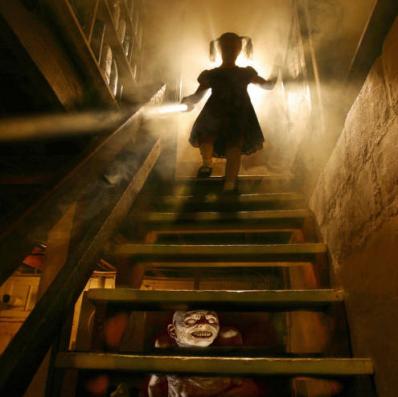
Image Credit: Joshua Hoffine
The monster itself is quite explicit, lurking under the basement stairs, but it awaits the unsuspecting, pig-tailed little girl making her way toward its grasp, not yet confronting the terror that awaits her.
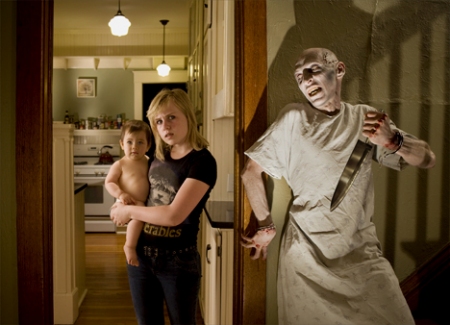
Image Credit: Joshua Hoffine
Hoffine also builds tension in some images of killers, though again, for me, with less effect. Above, we stand beyond a doorway looking into a kitchen. A young babysitter carries an infant, investigating a strange noise she heard just beyond the corner where we can see a maniacal killer waits with knife poised to strike. Below, we look through the keyhole of a door to discover the beheaded corpse of an ax murder victim, as the killer turns, ax in hand, to look back at us. For all three photos, the viewer's mind fills in what events next occur (or resists doing so), supplying a sense of impending doom that an explicit depiction of the moment of physical trauma alone (monster attack, knife attack, ax attack) would lack.
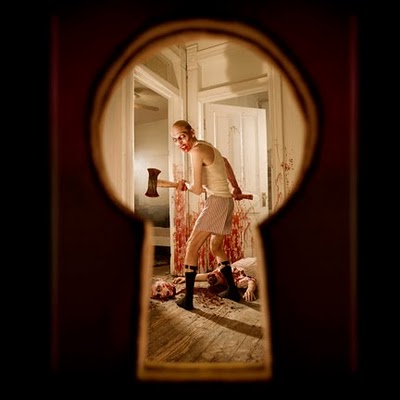
Image Credit: Joshua Hoffine
Un-imaged (and perhaps unimaginable) horror plays a central role in Hoffine's Pickman's Masterpice sequence. Hoffine explains the sequence in his behind-the-scenes blog (where he details the considerable work he, his crew and models go through). The sequence depicts a story by H.P. Lovecraft about an artist that paints realistic horrific images. In the sequence, we see the protagonist react to Pickman's masterpiece, but we do not see the painting itself, and again the viewer is left to fill in the blank.
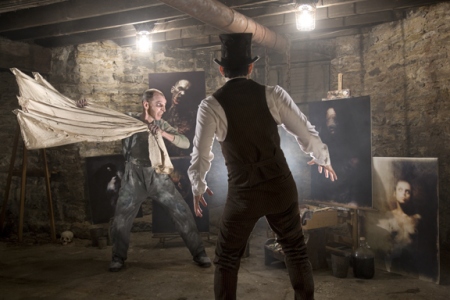
Image Credit: Joshua Hoffine
Recent comments
2 years 29 weeks ago
2 years 44 weeks ago
2 years 44 weeks ago
2 years 50 weeks ago
3 years 4 weeks ago
3 years 4 weeks ago
3 years 4 weeks ago
3 years 6 weeks ago
3 years 6 weeks ago
3 years 6 weeks ago